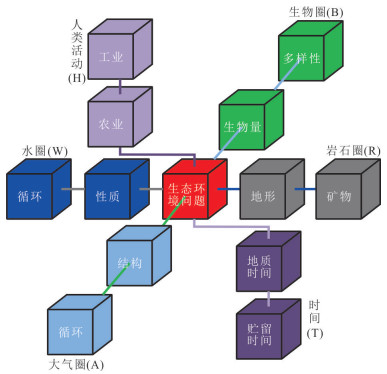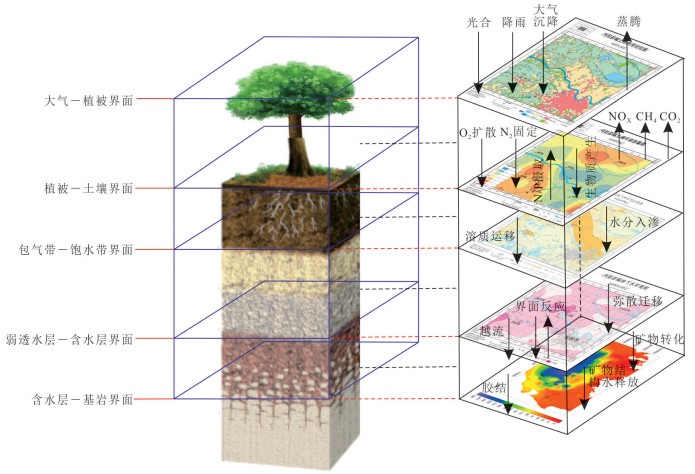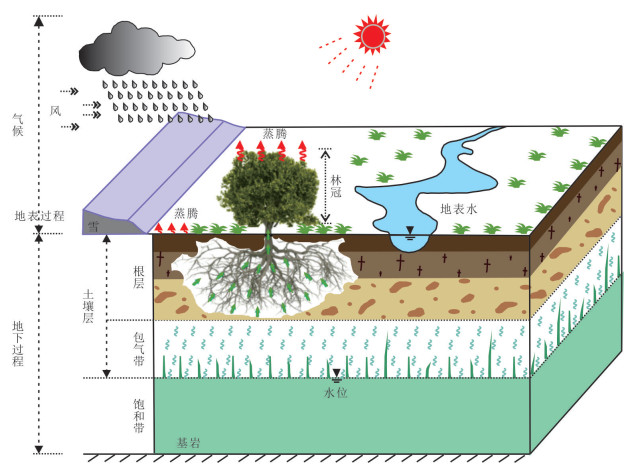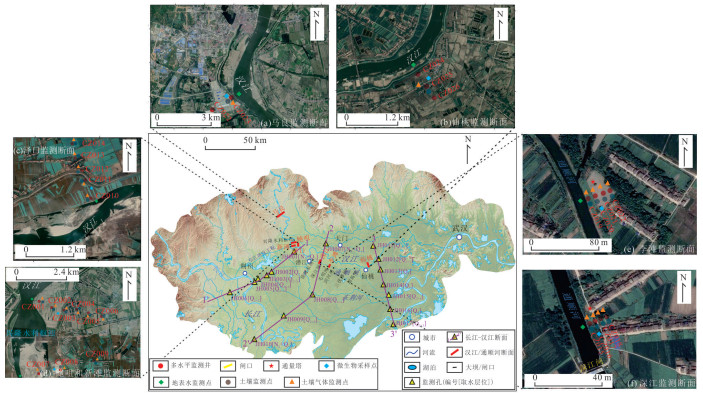Theoretical Approaches of Survey on Earth's Critical Zone in Basin: An Example from Jianghan Plain, Central Yangtze River
-
摘要: 围绕如何运用地球关键带理论解决巨型流域生态环境保护问题,在总结国内外地球关键带研究进展的基础上,结合在长江中游开展的地球关键带调查实践,将流域侵蚀基准面定义为流域地球关键带底边界,建立了流域生态环境问题库、地球四大圈层变量库和人类活动变量库;构建了以典型生态环境问题为导向的、基于地球系统四大圈层、人类活动和时间的六维环境变量矩阵;提出了流域地球关键带横向三断面和垂向五界面的结构概化模型,识别了各断面和界面的共性变量和特征变量.有效突破了传统地球关键带研究局限于小流域、环境变量梯度和生态环境问题相对单一的不足,科学回答了流域地球关键带“在哪里调查”、“调查什么”和“监测什么”的问题,初步构建了流域地球关键带调查理论方法体系,并在江汉平原进行了示范性研究.本文为长江流域地球关键带调查以及长江大保护战略的实施提供了科学依据,并为我国流域地球关键带调查理论方法体系的建立提供探索性经验.Abstract: Around how to use the theories of Earth's Critical Zone (CZ) to resolve ecological environment protection problem of large basin, it defines the base level of erosion for basin as the bottom boundary of CZ in basin, based on the domestic and foreign research progress on CZ in combination with survey on CZ in central Yangtze River basin. It conducted the ecological environment problem library of basin, the variable library of four spheres for earth and the variable library of anthropogenic activities. Based on "four spheres for earth", "anthropogenic activities" and "time", it also constructed the six-dimensional matrix guided by typical ecological environment problems. It proposes that three horizontal-sections and five vertical-interfaces as structural model of CZ in basin, and also identify the common/feature variables of sections and interfaces. According to the above results, we establish preliminary theoretical approaches of survey on CZ in basin and conduct an exemplary research in Jianghan Plain, which breaks through traditional CZ research limitation due to relatively single study on small watershed, gradient of environmental variable and ecological environment problems. We also answer the question on "where to survey", "what to survey" and "what to monitor" of CZ in basin. This study provides a scientific basis for survey of CZ in Yangtze River basin and implementation of Yangtze River protection, and exploratory experiences for the establishment of theoretical approaches of survey on CZ in basin.
-
Key words:
- basin /
- Earth's Critical Zone /
- six-dimensional matrix /
- Yangtze River /
- Jianghan plain /
- hydrogeology
-
表 1 四大圈层变量库
Table 1. Variable library of four spheres
圈层名称 变量库 水圈 水量、水质、水位、流速、水温、DO、pH、ORP、TDS、特征组分、蒸发量等 岩石圈 高程/埋深、年龄/暴露时间、岩性、容重、孔隙度、粒度、坡度、矿物、渗透系数、内摩擦角等 大气圈 温度、湿度、气压、风速、降雨、日照、辐射、云覆盖度、能见度、O3/CO2/O2/SO2等 生物圈 生物量、多样性指数、初级生物生产力、酶活性、微生物数量、光合作用、蒸腾量、根系等 表 2 流域地球关键带横向断面及垂向界面变量
Table 2. Variables for horizontal-section and vertical-interface of Earth's Critical Zone in basin
典型断面及界面 共性变量 特征变量 盆-山作用断面 地貌、岩性、坡度、水动力强度、流速等 输砂量、矿物、孔隙度、内摩擦角等 地表-地下水作用断面 地表-地下水交换量、水化学特征等 氚同位素、碳氮同位素等 海-陆作用断面 水文交换通量、水化学特征等 Cl-Br二维同位素 大气-植被界面 降水量、蒸散量、气温 温室气体分压、光合作用强度 植被-土壤界面 浅层土壤岩性、土壤水化学、根系结构及密度、土地利用类型 重金属含量、微生物数量、酶活性、土壤呼吸速率 包气带-饱水带界面 包气带厚度、结构、饱和渗透系数、水位 溶质下渗量、毛细水化学、微生物丰度 弱透水层-含水层界面 弱透水层岩性与化学组成、越流强度、孔隙水/地下水化学特征 物质交换通量、界面吸附、反应速率 含水层-基岩界面 区域地层结构、第四纪沉积物厚度、胶结程度 矿物组成、矿物结构水组成、地下水年龄、溶质下渗通量 表 3 流域地球关键带监测技术与要求
Table 3. Monitoring technologies and requirements for Earth's Critical Zone in basin
监测对象 监测指标 监测技术/仪器 监测频率 气象指标 风速、风向 小型通量塔、传感器 日尺度 气温、光照强度 小型通量塔、传感器 日尺度 湿度、干燥度 传感器 日尺度 降雨量、蒸发量 小型通量塔、传感器 日尺度 地表及地下结构 场地微地貌及地表三维建模(高程、坡度等) 无人机、CCD相机 单次 地表覆盖物信息 无人机、实地调查 单次 场地地质、水文地质结构 GEO-PROBE钻机 单次 场地三维结构 三维激电仪 单次 河床结构 多普勒河道扫描 单次 水 大气水 雨水水化学 雨量计、室内分析测试 月度或季度 地表水 流量、流速、径流深度等 流量/流速仪、声呐 月度或季度 地表水水化学 传感器、室内分析测试 月度或季度 土壤水 土壤水负压 土壤负压计 月度或季度 土壤含水率 TDR探头 日尺度 土壤水水化学 土壤水采样器、室内分析测试 月度或季度 地下水 地下水水位 关键带多水平监测点、传感器 日尺度 地下水流速、流向 地下水流速流向仪 月度或季度 地下水水温、水化学组分 关键带多水平监测点、室内分析测试 月度或季度 土 土壤 土壤剖面结构 包气带剖面观测点 月度或季度 土壤温度、湿度 传感器 日尺度 土壤物理特性(孔隙度、粒径等) 土壤采样器、激光粒度仪、CT扫描 单次 土壤组成与矿物成分 土壤采样器、XRD、XRF 单次 沉积物 河流沉积物 原状沉积物采样器 月度或季度 物理特性(孔隙度、渗透系数等) 水文地质试验、饱和渗透试验 月度或季度 岩性与矿物成分 GEO-PROBE钻机、XRD 单次 元素组成与有机质含量 GEO-PROBE钻机、XRF、元素分析仪 单次 气 大气 地表-大气界面气体通量(CO2或CH4) 静态气体箱 月度或季度 土壤气 土壤剖面气体含量 DIK-土壤气体采样器5212 月度或季度 生 地表植被 植被类型/丰度调查 无人机、野外实地调查 月度或季度 根系 根系观察仪 月度或季度 微生物 土壤酶含量 化学提取法 月度或季度 微生物类型(水、土) 高通量测序 月度或季度 -
An, P.J., Zhang, Z.Q., Wang, L.W., 2016.Review of Earth Critical Zone Research.Advances in Earth Science, 31(12):1228-1234(in Chinese with English abstract). http://en.cnki.com.cn/Article_en/CJFDTOTAL-DXJZ201612004.htm Anderson, R.S., 2015.Pinched Topography Initiates the Critical Zone.Science, 350(6260):506-507. https://doi.org/10.1126/science.aad2266 Banwart, S.A., Nikolaidis, N.P., Zhu, Y.G., et al., 2019.Soil Functions:Connecting Earth's Critical Zone.Annual Review of Earth and Planetary Sciences, 47(1):333-359. doi: 10.1146/annurev-earth-063016-020544 Cai, S.M., Zhou, X.Y., 1996.The Impact of Human Activities on the Wetland Ecological System in the Middle Reaches of the Changjiang River.Scientia Geographica Sinica, 16(2):129-136(in Chinese with English abstract). http://europepmc.org/abstract/CBA/292440 Chorover, J., Troch, P.A., Rasmussen, C., et al., 2011.How Water, Carbon, and Energy Drive Critical Zone Evolution:The Jemez-Santa Catalina Critical Zone Observatory.Vadose Zone Journal, 10(3):884-899. https://doi.org/10.2136/vzj2010.0132 Du, Y., Deng, Y.M., Ma, T., et al., 2020.Spatial Variability of Nitrate and Ammonium in Pleistocene Aquifer of Central Yangtze River Basin.Groundwater, 58(1):110-118. https://doi.org/10.1111/gwat.12888 Fan, Y., 2015.Groundwater in the Earth's Critical Zone:Relevance to Large-Scale Patterns and Processes.Water Resources Research, 51(5):3052-3069. https://doi.org/10.1002/2015wr017037 Giardino, J.R., Houser, C., 2015.Principles and Dynamics of the Critical Zone.Elsevier, Amsterdam. http://www.bokus.com/cgi-bin/product_search.cgi?authors=Chris%20Houser Gu, Y.S., Guan, S., Ma, T., et al., 2018.Quaternary Sedimentary Environment Documented by Borehole Stratigraphical Records in Eastern Jianghan Basin.Earth Science, 43(11):3989-4000(in Chinese with English abstract). http://en.cnki.com.cn/Article_en/CJFDTotal-DQKX201811015.htm Gu, Y.S., Li, K.J., Qin, Y.M., et al., 2013.Impact of Human Activity on the Evolution of the Ecological Environment of Jianghan Lake Group in the Historical Period, Central China.Earth Science, 38(Suppl.1):133-144(in Chinese with English abstract). Healy, R.W., 2008.Simulating Water, Solute, and Heat Transport in the Subsurface with the VS2DI Software Package.Vadose Zone Journal, 7(2):632-639. https://doi.org/10.2136/vzj2007.0075 Hissler, C., Stille, P., Guignard, C., et al., 2014.Rare Earth Elements as Hydrological Tracers of Anthropogenic and Critical Zone Contributions:A Case Study at the Alzette River Basin Scale.Procedia Earth and Planetary Science, 10:349-352. https://doi.org/10.1016/j.proeps.2014.08.036 Hoffman, B.S., Anderson, R.S., 2014.Tree Root Mounds and Their Role in Transporting Soil on Forested Landscapes.Earth Surface Processes and Landforms, 39(6):711-722. https://doi.org/10.1002/esp.3470 Holbrook, W.S., Marcon, V., Bacon, A.R., et al., 2019.Links between Physical and Chemical Weathering Inferred from a 65 m Deep Borehole through Earth's Critical Zone.Scientific Reports, 9(1). https://doi.org/10.1038/s41598-019-40819-9 Lepore, C., Arnone, E., Noto, L.V., et al., 2013.Physically Based Modeling of Rainfall-Triggered Landslides:A Case Study in the Luquillo Forest, Puerto Rico.Hydrology and Earth System Sciences, 17(9):3371-3387. https://doi.org/10.5194/hess-17-3371-2013 Lewis, S.L., Maslin, M.A., 2015.Defining the Anthropocene.Nature, 519:171-180. https://doi.org/10.1038/nature14258 Li, C.A., Yin, H.F., Yu, L.Z., et al., 2001.Some Consideration on Evolution and Control of Ecological Environment System in Yangtze Basin.Resources and Enuironment in the Yangtze Basin, 10(6):550-557(in Chinese with English abstract). http://en.cnki.com.cn/Article_en/CJFDTOTAL-CJLY200106010.htm Li, J.F., 2016.Recognize the Economic Situation and Follow the New Trend of Reform-Accelerating the Adjustment and Reform of Geological Survey in China.Geological Survey of China, 3(1):1-6(in Chinese with English abstract). Lin, H., 2010.Earth's Critical Zone and Hydropedology:Concepts, Characteristics, and Advances.Hydrology and Earth System Sciences, 14(1):25-45. https://doi.org/10.5194/hess-14-25-2010 Liu, R., Ma, T., Qiu, W.K., et al., 2020.Effects of Fe Oxides on Organic Carbon Variation in the Evolution of Clayey Aquitard and Environmental Significance.Science of the Total Environment, 701:134776. https://doi.org/10.1016/j.scitotenv.2019.134776 McBride, D., Cross, M., Croft, N., et al., 2006.Computational Modelling of Variably Saturated Flow in Porous Media with Complex Three-Dimensional Geometries.International Journal for Numerical Methods in Fluids, 50(9):1085-1117. https://doi.org/10.1002/fld.1087 Menon, M., Rousseva, S., Nikolaidis, N.P., et al., 2014.SoilTrEC:A Global Initiative on Critical Zone Research and Integration.Environmental Science and Pollution Research, 21(4):3191-3195. https://doi.org/10.1007/s11356-013-2346-x Minor, J., Pearl, J.K., Barnes, M.L., et al., 2020.Critical Zone Science in the Anthropocene:Opportunities for Biogeographic and Ecological Theory and Praxis to Drive Earth Science Integration.Progress in Physical Geography:Earth and Environment, 44(1):50-69. https://doi.org/10.1177/0309133319864268 National Research Council, 2001.New Research Opportunities in the Earth Sciences.National Academies Press, Washington D.C.. https://doi.org/10.17226/13236 Ness, B., Anderberg, S., Olsson, L., 2010.Structuring Problems in Sustainability Science:The Multi-Level DPSIR Framework.Geoforum, 41(3):479-488. https://doi.org/10.1016/j.geoforum.2009.12.005 Pikul, M.F., Street, R.L., Remson, I., 1974.A Numerical Model Based on Coupled One-Dimensional Richards and Boussinesq Equations.Water Resources Research, 10(2):295-302. https://doi.org/10.1029/wr010i002p00295 Richter, D.D., Billings, S.A., 2015.'One Physical System':Tansley's Ecosystem as Earth's Critical Zone.The New Phytologist, 206(3):900-912. https://doi.org/10.1111/nph.13338 Shen, S., Ma, T., Du, Y., et al., 2019.Temporal Variations in Groundwater Nitrogen under Intensive Groundwater/Surface-Water Interaction.Hydrogeology Journal, 27(5):1753-1766. https://doi.org/10.1007/s10040-019-01952-x Shi, Y.N., Eissenstat, D.M., He, Y.T., et al., 2018.Using a Spatially-Distributed Hydrologic Biogeochemistry Model with a Nitrogen Transport Module to Study the Spatial Variation of Carbon Processes in a Critical Zone Observatory.Ecological Modelling, 380:8-21. https://doi.org/10.1016/j.ecolmodel.2018.04.007 Steffen, W., Leinfelder, R., Zalasiewicz, J., et al., 2016.Stratigraphic and Earth System Approaches to Defining the Anthropocene.Earth's Future, 4(8):324-345. https://doi.org/10.1002/2016ef000379 Sun, J.L., Lei, X.H., Tian, Y., et al., 2013.Hydrological Impacts of Climate Change in the Upper Reaches of the Yangtze River Basin.Quaternary International, 304:62-74. https://doi.org/10.1016/j.quaint.2013.02.038 Tague, C.L., Band, L.E., 2004.RHESSys:Regional Hydro-Ecologic Simulation System:An Object-Oriented Approach to Spatially Distributed Modeling of Carbon, Water, and Nutrient Cycling.Earth Interactions, 8(19):1-42. doi: 10.1175/1087-3562(2004)8<1:RRHSSO>2.0.CO;2 Wang, L.X., Liang, X., Li, J., 2020.Analysis of Origin of Groundwater in Jianghan Plain Based on Typical Drillings.Earth Science, 45(2):701-710(in Chinese with English abstract). White, T., Brantley, S., Banwart, S., et al., 2015.The Role of Critical Zone Observatories in Critical Zone Science.Developments in Earth Surface Processes, 19:15-78. https://doi.org/10.1016/b978-0-444-63369-9.00002-1 Xu, X.L., Liu, W., 2017.The Global Distribution of Earth's Critical Zone and Its Controlling Factors.Geophysical Research Letters, 44(7):3201-3208. https://doi.org/10.1002/2017gl072760 Yang, J.F., Zhang, C.G., 2014.Earth's Critical Zone:A Holistic Framework for Geo-Environmental Researches.Hydrogeology and Engineering Geology, 41(3):99-104, 110(in Chinese with English abstract). http://en.cnki.com.cn/Article_en/CJFDTOTAL-SWDG201403020.htm Yang, Y.P., Wang, P., Yan, H.J., et al., 2019.NH4H2PO4-Extractable Arsenic Provides a Reliable Predictor for Arsenic Accumulation and Speciation in Pepper Fruits (Capsicum annum L.).Environmental Pollution, 251:651-658. https://doi.org/10.1016/j.envpol.2019.05.042 Ye, D.Z., Fu, C.B., Ji, J.J., et al., 2001.Orderly Human Activities and Subsistence Environment.Advance in Earth Science, 16(4):453-460(in Chinese with English abstract). http://ci.nii.ac.jp/naid/10018882236 Zhang, Y., Slingerland, R., Duffy, C., 2016.Fully-Coupled Hydrologic Processes for Modeling Landscape Evolution.Environmental Modelling & Software, 82:89-107. https://doi.org/10.1016/j.envsoft.2016.04.014 Zhu, Y.G., Li, G., Zhang, G.L., et al., 2015.Soil Security:From Earth's Critical Zone to Ecosystem Services.Acta Geographica Sinica, 70(12):1859-1869(in Chinese with English abstract). http://en.cnki.com.cn/Article_en/CJFDTotal-DLXB201512002.htm 安培浚, 张志强, 王立伟, 2016.地球关键带的研究进展.地球科学进展, 31(12):1228-1234. https://www.cnki.com.cn/Article/CJFDTOTAL-DXJZ201612004.htm 蔡述明, 周新宇, 1996.人类活动对长江中游湿地生态系统的冲击.地理科学, 16(2):129-136. https://www.cnki.com.cn/Article/CJFDTOTAL-DLKX199602004.htm 顾延生, 管硕, 马腾, 等, 2018.江汉盆地东部第四纪钻孔地层与沉积环境.地球科学, 43(11):3989-4000. doi: 10.3799/dqkx.2018.324 顾延生, 李贶家, 秦养民, 等, 2013.历史时期以来人类活动与江汉湖群生态环境演变.地球科学, 38(增刊1):133-144. https://www.cnki.com.cn/Article/CJFDTOTAL-DQKX2013S1016.htm 李长安, 殷鸿福, 俞立中, 等, 2001.关于长江流域生态环境系统演变与调控研究的思考.长江流域资源与环境, 10(6):550-557. doi: 10.3969/j.issn.1004-8227.2001.06.011 李金发, 2016.认清经济新形势, 顺应改革新趋势:加快中国地质调查工作的调整与改革.中国地质调查, 3(1):1-6. https://www.cnki.com.cn/Article/CJFDTOTAL-DZDC201601001.htm 王露霞, 梁杏, 李静, 2020.基于典型钻孔的江汉平原地下水成因分析.地球科学, 45(2):701-710. doi: 10.3799/dqkx.2018.363 杨建锋, 张翠光, 2014.地球关键带:地质环境研究的新框架.水文地质工程地质, 41(3):98-104, 110. https://www.cnki.com.cn/Article/CJFDTOTAL-SWDG201403020.htm 叶笃正, 符淙斌, 季劲钧, 等, 2001.有序人类活动与生存环境.地球科学进展, 16(4):453-460. doi: 10.3321/j.issn:1001-8166.2001.04.001 朱永官, 李刚, 张甘霖, 等, 2015.土壤安全:从地球关键带到生态系统服务.地理学报, 70(12):1859-1869. doi: 10.11821/dlxb201512001 -









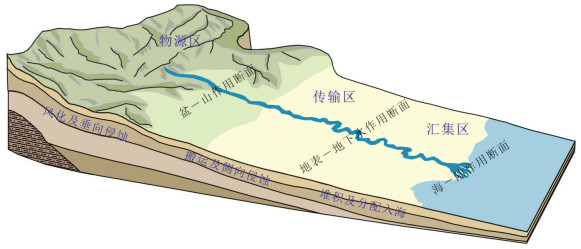
 下载:
下载:
